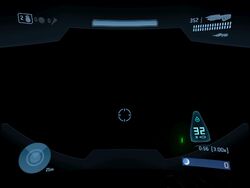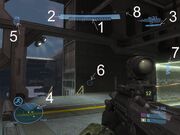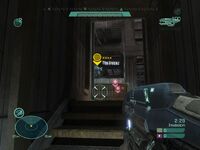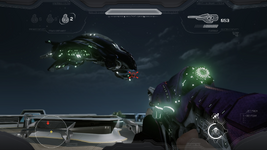mNo edit summary |
|||
| Line 46: | Line 46: | ||
==Gallery== |
==Gallery== |
||
| − | <gallery widths=" |
+ | <gallery widths="200" spacing="small" orientation="landscape"> |
MJOLNIR HUD.jpg|HUD for [[MJOLNIR Powered Assault Armor#MJOLNIR Mark V|MJOLNIR Mk. V]], from ''[[Halo: Combat Evolved]]''. |
MJOLNIR HUD.jpg|HUD for [[MJOLNIR Powered Assault Armor#MJOLNIR Mark V|MJOLNIR Mk. V]], from ''[[Halo: Combat Evolved]]''. |
||
MjolnirMKVIHUD.jpg|The [[MJOLNIR Powered Assault Armor#MJOLNIR Mark VI|MJOLNIR Mk. VI]] HUD from ''[[Halo 2]]''. |
MjolnirMKVIHUD.jpg|The [[MJOLNIR Powered Assault Armor#MJOLNIR Mark VI|MJOLNIR Mk. VI]] HUD from ''[[Halo 2]]''. |
||
| Line 60: | Line 60: | ||
Halo Reach - HUD.jpg|The Mark V HUD in ''Halo: Reach''. |
Halo Reach - HUD.jpg|The Mark V HUD in ''Halo: Reach''. |
||
H3ODST_Campaign_1stPersonVISR.jpg|The ODST HUD |
H3ODST_Campaign_1stPersonVISR.jpg|The ODST HUD |
||
| − | + | Halo_4_HUD.jpg|The HUD in ''[[Halo 4]]'' Campaign |
|
| − | halo 4 hud 2.JPG|The HUD in ''Halo 4'' |
+ | halo 4 hud 2.JPG|The HUD in ''[[Halo 4]]'' Multiplayer |
The_final_HUD_running_in-game.jpg|''Halo 4'' Final HUD Layout |
The_final_HUD_running_in-game.jpg|''Halo 4'' Final HUD Layout |
||
Halo 4 HUD Concept.jpg|''Halo 4'' Master Chief hud concept |
Halo 4 HUD Concept.jpg|''Halo 4'' Master Chief hud concept |
||
| + | ContingencyHUD.png|The HUD in ''[[Project Contingency]]'' |
||
ForwardUntoDawnHUD.png|A trainee soldier's HUD as seen in ''[[Halo 4: Forward Unto Dawn]]'' |
ForwardUntoDawnHUD.png|A trainee soldier's HUD as seen in ''[[Halo 4: Forward Unto Dawn]]'' |
||
kat's HUD.jpg|Kat-320's HUD during the Deliver Hope trailer. |
kat's HUD.jpg|Kat-320's HUD during the Deliver Hope trailer. |
||
Revision as of 12:08, 12 July 2014

The MJOLNIR Mk. VI variant's HUD as seen in Halo 3.
A heads-up display (HUD) is a translucent display that presents data while minimizing any obstruction to the user's view.
Summary
The HUD is the main source for information in-game on Halo: Combat Evolved, Halo 2, Halo 3, Halo Reach, and Halo 4, though the appearance of the HUD has changed dramatically from its predecessors.[1][2][3] The sensors augmented into the Spartan's body display the soldier's vital signs, which include a measure of their overall health in the form of bars. Note that this "health bar" has been removed from Halo 2 and Halo 3, with the reason being the insertion of automatic biofoam injectors into the Mark VI armor.[4] In Halo 3, there a slight convex appearance to simulate looking through a real visor. Also, the MJOLNIR shields flare up in a grid-shaped pattern, to simulate the player is taking damage. Additionally, the HUD also reports the strength of the wearer's shields through the energy signatures it emanates. Weapons' heat and ammunition levels, as well as grenade type and count are also detected through sensors placed in the Spartan's gloves. In Halo 2 and 3, the Mark VI armor is able to register two weapons when the Spartan is dual-wielding.
Another notable feature on the HUD is that each type of weapon that the gloves detect has its own unique aiming reticule in relation to the type of ammo that it projects and it's statistics. Even heavy weapons have their own reticules. For example, the open circle reticule on the shotgun tells you that although the shot will land somewhere in the directed area, the distance and position are rather unpredictable. Or the Ghost's reticule tells you that the plasma shots will travel as far as the two dots show, but can drift off left or right a little. The reticule is also compatible with the scope of ranged weapons when installed. However, do remember that it is a reticule that is designed to aid the person in pinpointing where the shot will end up, while an aiming cursor shows exactly where the shot will end up.
The Motion Sensor is another important feature displayed on the HUD. It can sense and track movement in a 15 meter radius (Halo: CE), a 20 meter radius (Halo 2) and a 25 meter radius (Halo 3). Due to the insertion of IFF tags in UNSC soldiers, the radar can distinguish friend (yellow) from foe (red). Finally, the way point indicators are an on-screen directive that point out important objectives or locations in the Spartan's mission, and are extremely useful, measuring the distance the Spartan is from the objective.
A HUD is featured on SPI Armor, MJOLNIR armor, ODST battle armor, Marine Body Armor, and even the Sangheili Combat Harness.
Helmet Readouts
MJOLNIR Armor, SPI Armor, and Sangheili Armor

A reference chart of the HUD in Halo: Reach.
- Main article: MJOLNIR Powered Assault Armor
The standard MJOLNIR armor contains the following readouts:
- (1) A meter displaying the user's health (only in Halo: Combat Evolved and Halo: Reach).
- Grenade tracking. (only available on MJOLNIR GEN 2 armor)
- (2) A gauge displaying Shield integrity status. (absent from ODST armor and SPI armor as it has no shields)
- (3) A gauge tracking the quantity of ammunition available for weapons carried.
- (4) A motion tracker. (absent from Halo 3: ODST)
- (5) A counter tracking the number and type of Grenades carried.
- (6) A targeting reticule which changes relative to the weapon currently in use.
- (7) Acknowledgment lights from other members of the wearer's team.
- (8) Maps and information uploaded over the wearer's TACCOM (seen only in Halo 3: ODST's VISR Database)--translated to a compass in Halo: Reach.
- (9) Zoom Function.
- Function for using a Fiber Optic Probe. (absent from gameplay)
ODST Armor and Marine Body Armor
The Heads-Up-Display used by UNSC Marine Corps and ODST's is similar to that used by Spartans, displaying weapons and grenades carried by the user and their ammunition, and projecting a targeting reticule to assist aim. However, it is notable for lacking several functions, such as the motion tracker and shield bar, which are unavailable for conventional UNSC personnel, though it does display health information. Additionally, ODST helmets integrate a VISR that improves the users vision in low light areas, also outlining objects in the immediate area - green outlines are "friendly" units, red outlines are "enemy combatants" and blue outlines are discarded or abandoned equipment and weaponry that can be used. The system can also track data and display tactical information, such as maps and waypoints.
Terminology
Although the games, novels and manuals all refer to a Heads-Up Display (HUD), this is technically an incorrect description of the equipment featured in-universe. By definition, a Heads-Up Display is a fixed unit where by you must look up in order to see it. For example, the HUD in a fighter jet is mounted to the glareshield and cannot be moved. If the pilot looks to his left or right, he can no longer see the display.
The term HUD originally came from looking 'up' out of the cockpit as opposed to looking down at the gauges on the instrument panel. The correct in-universe term for the equipment in the Halo games is a Helmet Mounted Display (HUD), or HMD. A display mounted or projected onto a helmets visor, the result of which being that no matter where the wearer looks, the display will remain in front of his eyes. HMD's have been in military service as early as the late 1970s when the Soviet Union was developing the MiG-29 Fulcrum and are currently starting replacing HUD's in the newest generation of fighter jets, and the new Lockheed Martin F-35 Lightning II does not feature a HUD at all, instead completely relying upon the pilots HMD.
Trivia
- The HUD in Halo 2 is the only one in the trilogy that does not display any kind of information on the direction of the fire when the player is hit. Both Halo Combat Evolved and Halo 3 show arrows that show the player where the shots came from.
- In Halo: Reach, when your shields are down, the word "Warning" will show up in the depleted shield indicator. Also, if your health is below yellow it will continuously flash.
- In the Halo Reach campaign, the Heads Up Display gives the player a brief description of the weapon they are currently using by pressing the Back button.
- In Halo 3 and Halo 3: ODST, the HUD seems to resemble the visor shape of the helmet.
- In Halo 4, the HUD is fully 3-dimensional, and bobs and weaves with the player's movement. Additionally, portions of the player's helmet can be seen at the edges of the screen if he/she is in a first-person view, but you can't see the edges in Multiplayer.
- A more accurate term for an in-universe heads-up display is a helmet mounted display.




















